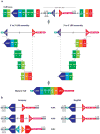VLR-based adaptive immunity
- PMID: 22224775
- PMCID: PMC3526378
- DOI: 10.1146/annurev-immunol-020711-075038
VLR-based adaptive immunity
Abstract
Lampreys and hagfish are primitive jawless vertebrates capable of mounting specific immune responses. Lampreys possess different types of lymphocytes, akin to T and B cells of jawed vertebrates, that clonally express somatically diversified antigen receptors termed variable lymphocyte receptors (VLRs), which are composed of tandem arrays of leucine-rich repeats. The VLRs appear to be diversified by a gene conversion mechanism involving lineage-specific cytosine deaminases. VLRA is expressed on the surface of T-like lymphocytes; B-like lymphocytes express and secrete VLRB as a multivalent protein. VLRC is expressed by a distinct lymphocyte lineage. VLRA-expressing cells appear to develop in a thymus-like tissue at the tip of gill filaments, and VLRB-expressing cells develop in hematopoietic tissues. Reciprocal expression patterns of evolutionarily conserved interleukins and chemokines possibly underlie cell-cell interactions during an immune response. The discovery of VLRs in agnathans illuminates the origins of adaptive immunity in early vertebrates.
Figures




References
-
- Perey DY, Finstad J, Pollara B, Good RA. Evolution of the immune response. VI First and second set skin homograft rejections in primitive fishes. Lab Invest. 1968;19:591–97. - PubMed
-
- Raison RL, Gilbertson P, Wotherspoon J. Cellular requirements for mixed leucocyte reactivity in the cyclostome, Eptatretus stoutii. Immunol Cell Biol. 1987;65(Pt. 2):183–88. - PubMed
Publication types
MeSH terms
Substances
Grants and funding
LinkOut - more resources
Full Text Sources
Other Literature Sources

